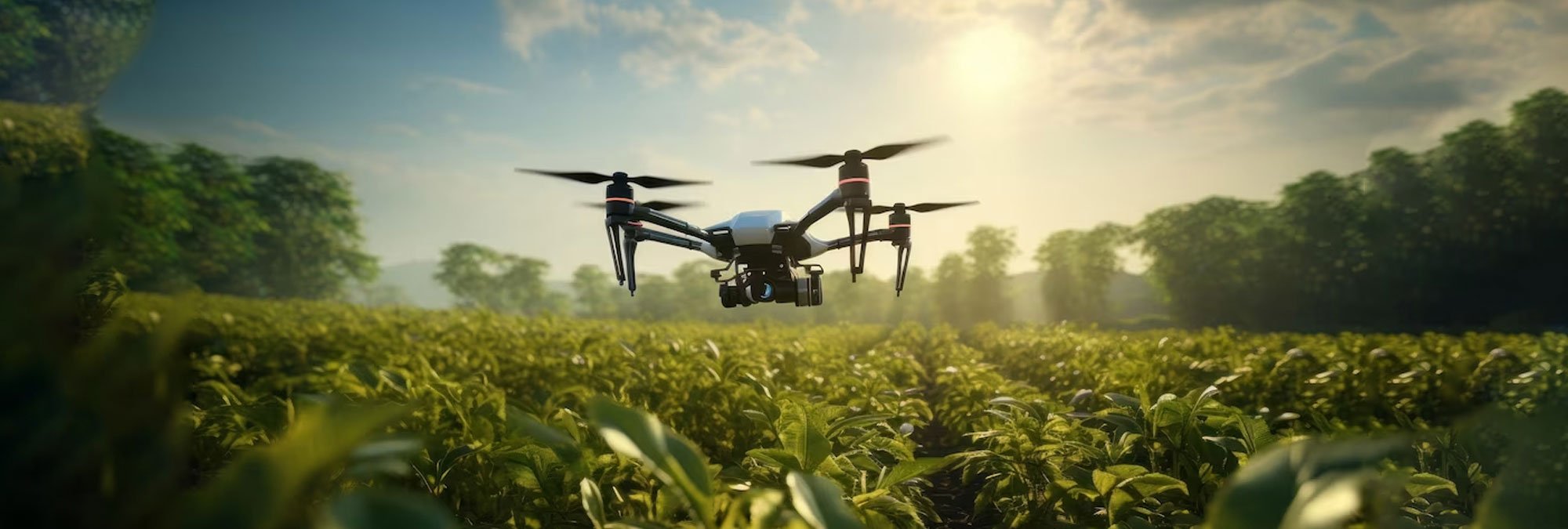In recent years, the agricultural industry has experienced a transformative shift with the introduction of agricultural drones. These unmanned aerial vehicles (UAVs) have revolutionised farming practices, offering farmers a wide array of benefits, from precision agriculture to increased efficiency and cost-effectiveness.
This article delves into the world of agricultural drones, exploring their advantages, applications, types, selection criteria, regulations, case studies, and future trends.
Advantages of Agricultural Drones
1. Precision Agriculture:
Agricultural drones enable farmers to apply fertilisers, pesticides, and water with unparalleled precision. By precisely targeting inputs, farmers can maximise crop yields while minimising waste, resulting in improved profitability and sustainability.
2. Increased Efficiency:
Drones allow farmers to cover large areas of land quickly and easily, reducing the time and labour required for traditional farming methods. This increased efficiency translates to cost savings and improved productivity.
3. Cost-effectiveness:
Despite their initial investment cost, agricultural drones can be cost-effective in the long run. By reducing the need for manual labour and optimising input use, drones can lead to significant cost savings over time.
4. Environmental Benefits:
Agricultural drones can help reduce the environmental impact of farming by enabling more precise application of inputs. By applying fertilisers and pesticides only where they are needed, drones can reduce pollution and soil erosion.
How Agricultural Drones Work
Agricultural drones are equipped with various sensors and imaging devices that allow them to collect data about crop health, soil conditions, and other relevant factors. These drones are typically controlled remotely by a trained operator and can fly autonomously or be guided manually.
The main components of an agricultural drone include the airframe, which houses the drone’s propulsion system and payload, the flight controller, which controls the drone’s flight path, and the sensors, which collect data about the field.
Types of sensors used in agricultural drones include multispectral cameras, which capture images in multiple wavelengths of light, allowing farmers to assess crop health, and thermal cameras, which detect temperature differences in the field, helping identify irrigation issues and pest infestations.
Applications of Agricultural Drones
1. Crop Monitoring and Management:
Agricultural drones can provide real-time data on crop health, allowing farmers to identify issues such as nutrient deficiencies or pest infestations early and take corrective action.
2. Irrigation Management:
Drones can monitor soil moisture levels and apply water only where it is needed, reducing water waste and improving crop yields.
3. Soil Analysis:
Drones can assess soil health and make informed decisions about fertiliser application, leading to improved soil quality and crop productivity.
4. Pest Control:
Drones can monitor pest populations and apply pesticides only where they are needed, reducing the need for blanket pesticide application and minimising environmental impact.
Types of Agricultural Drones
There are several types of agricultural drones available, each with its own set of features and capabilities. Fixed-wing drones are designed for long-distance flight and are ideal for large farms.
Multi-rotor drones, on the other hand, are more manoeuvrable and can hover in place, making them suitable for smaller farms or for use in areas with limited space. Hybrid drones combine the benefits of both fixed-wing and multi-rotor drones, offering both long-distance flight and manoeuvrability.
Selecting the Right Agricultural Drone
When selecting an agricultural drone, farmers should consider factors such as the size of their farm, the type of crops they grow, and their budget. They should also consider the type of sensors they need, as different sensors are suitable for different types of crops and applications.
Regulations and Safety Guidelines for Agricultural Drones
Before flying an agricultural drone, it is essential to be aware of the regulations and safety guidelines that apply in your area. In most countries, drones are subject to strict regulations, including restrictions on where and when they can be flown.
It is also important to follow safety guidelines to ensure that you do not endanger yourself or others while flying your drone.
Case Studies of Successful Drone Implementation in Agriculture
There are many examples of successful drone use in agriculture. For example, drones have been used to monitor crop health, assess soil conditions, and even to plant crops.
In one case study, a farmer used a drone equipped with a multispectral camera to identify areas of nutrient deficiency in his crops and apply fertiliser only where it was needed, resulting in a significant increase in yields.
Future Trends in Agricultural Drone Technology
The future of agricultural drone technology looks bright, with advancements in drone technology continuing to improve the capabilities of these devices. One exciting development is the use of artificial intelligence (AI) to analyse drone data and provide farmers with actionable insights.
Other potential future applications of drones in agriculture include the use of drones for crop spraying, planting, and even harvesting.
Final Thoughts
Agricultural drones have the potential to revolutionise modern farming practices, offering farmers the ability to monitor and manage their fields with unprecedented precision and efficiency.
By understanding how these drones work, their benefits, types, selection criteria, regulations, case studies, and future trends, farmers can make informed decisions about integrating this technology into their operations.
With the right drone and the right strategy, farmers can soar to success and achieve greater success than ever before.
Precision Ag Services is a local family run business based within the Lockyer Valley and serves South East Queensland and beyond. Depending on what is needed Precision Ag Services is here to help you.
Please fill out our enquiry form for more information or to make a booking.


